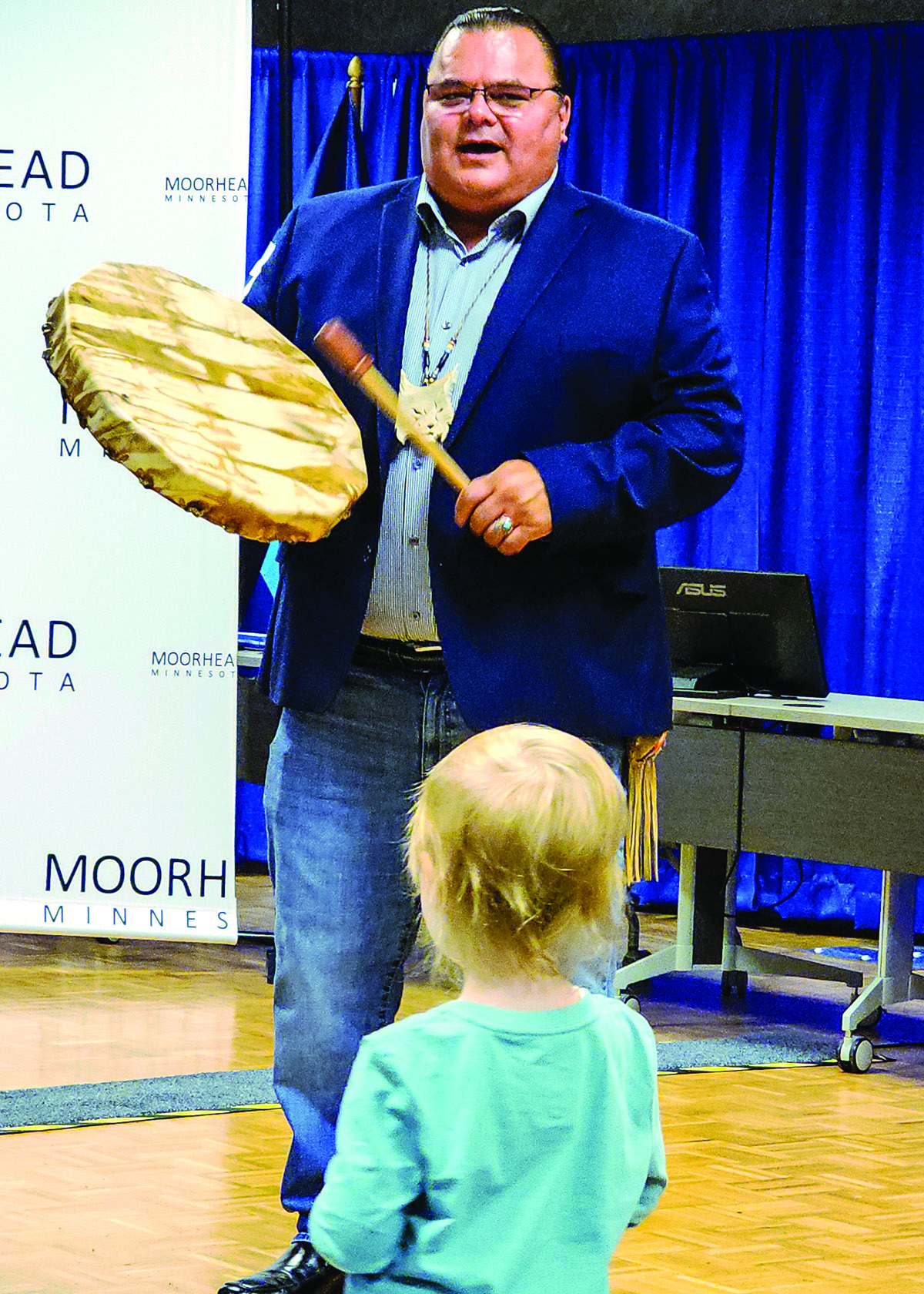
Little Olivia Graves watches with rapt attention as educator Ricky White closes Monday’s event with his eagle drum. (Photos/Nancy Hanson.)

A full house heard speaker Ricky White, along with the Singing Drum, at Monday’s Indigenous Day event at the Hjemkomst Center.
Nancy Edmonds Hanson
Guests were just polishing off their “indigi-bowl” lunches of wild rice and buffalo when Brandon Baity approached educator Ricky White with a gift – a pinch of tobacco.
It was an instant initiation into the topic of the day – the traditions and culture of the first to call the area their home. White’s presentation Monday highlighted Indigenous Peoples Day, celebrated for the fifth time in Moorhead and just the second officially proclaimed by the state of Minnesota.
Indigenous Peoples Day has replaced Columbus Day here, as it has in many communities from coast to coast. It turns the focus of the autumn holiday inside out: Instead of focusing on the fabled European explorer who stumbled on the Caribbean in his quest for the shores of India, the new designation honors the 5 million people who already lived in North America.
Baity’s gift of tobacco, White explained to the full house gathered at the Hjemkomst Center, was a sign of respect in Native American culture, traditionally used when asking elders for help or guidance. That’s a lesson he has shared with students in the Fargo public schools, where he is a cultural specialist in the Native American education program … and one that required educating school officials themselves.
“Our schools are tobacco-free buildings,” he said. “But this is tobacco used in the right way.” Ultimately the district added an exception to its policy, based on his explanation of its role in Native culture. Today students are allowed to carry loose tobacco for offering or asking, he explained, “honoring and respecting the use of tobacco as it was originally intended.”
The pinch of tobacco proffered by Baity was just one of the simple, yet significant, cultural lessons White shared during his Lunch and Learn program at the Hjemkomst Center. He welcomed his audience with “boozhoo,” the Ojibwe greeting, and ended it with “miigwetch,” or “thanks.” In between, he taught the hundred-plus people in attendance how to introduce themselves in the Ojibwe language, the symbolism of braiding a family member’s hair and the Native gesture of pointing with their lips rather than fingers.
“That’s cultural intelligence,” he pointed out. “Next time, you’ll know what it is.”
As the crowd tried their first Ojibwe words and gestured with their lips, the room rocked with high spirits. But tasting a bit of traditional culture was only part of the message White delivered, as he turned to hard facts about Indigenous life since the coming of the explorer the day no longer honors.
Columbus’s landing on the island of San Salvador in the Bahamas on Oct. 12, 1492, was the first expression of what Pope Alexander VI would declare the following year – the Doctrine of Discovery. Said White, “It gave Europeans the right and passage to conquer all lands and peoples who were not Christian, and had a devastating impact on native peoples, who were said to be ‘occupying the lands like animals.’”
Besides the India-seeking mariner’s arrival on an entirely different continent, White noted, he assumed all its inhabitants were one group – compounding his directional error by dubbing them “Indians.” In truth, he said, the 5 million living in North America at the time represented hundreds of nations.
The arrival of Europeans over the following centuries spelled disaster. “The establishment of the 13 colonies launched the biggest extermination in history,” he said. He told of Lord Jeffery Amherst, the commanding general of the British forces, who introduced what White called “one of the original bioterrorists.” Amherst’s men gathered smallpox-laced blankets from hospitals and graveyards, then presented them to natives as gifts. Hundreds of thousands died.
White told of the Trail of Tears. As the United States pushed westward, East Coast tribes were forced toward the center of the continent. “Extraction – that was the playbook,” he said. The most graphic evidence is in Oklahoma: “Forty-plus tribes live there today. Only four were original.”
Minnesota, too, played a part. After the U.S.-Dakota War of 1862, the state paid a bounty for the scalps of dead Indians. It started at $25; later, any citizen who could prove he killed an Indian was awarded $75. According to the newspaper in Winona, it had reached $200 by the end of 1863.
His goal, the speaker told his audience, is not to make people feel bad about the past, but to encourage them to understand. “This is part of all of us who live in Moorhead, in Fargo, in West Fargo,” he said. We need to know this. It doesn’t feel good, but the question is this: What can we do about it?”
He urged his audience not to ask “what’s wrong with you?” – but rather, “what happened to you?”
“We are struggling with our identity,” the former Minnesota Indian Educator of the Year told his rapt, mostly white audience. “It’s hard to feel accepted, to feel respected, when we have lost so much.”


